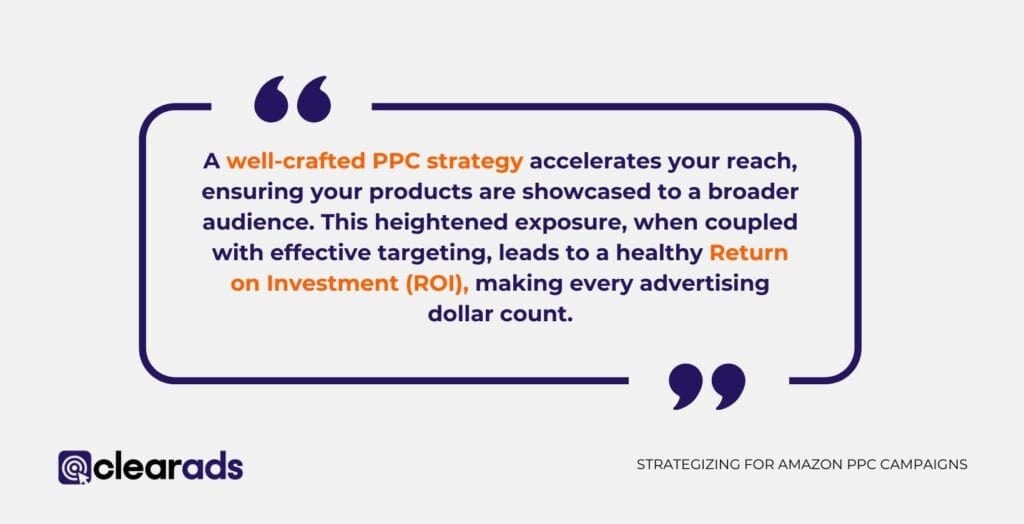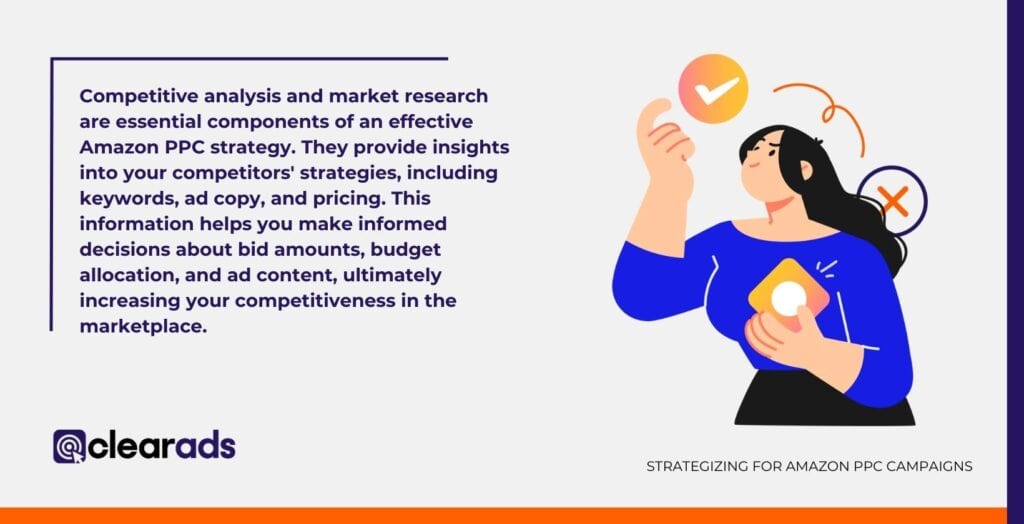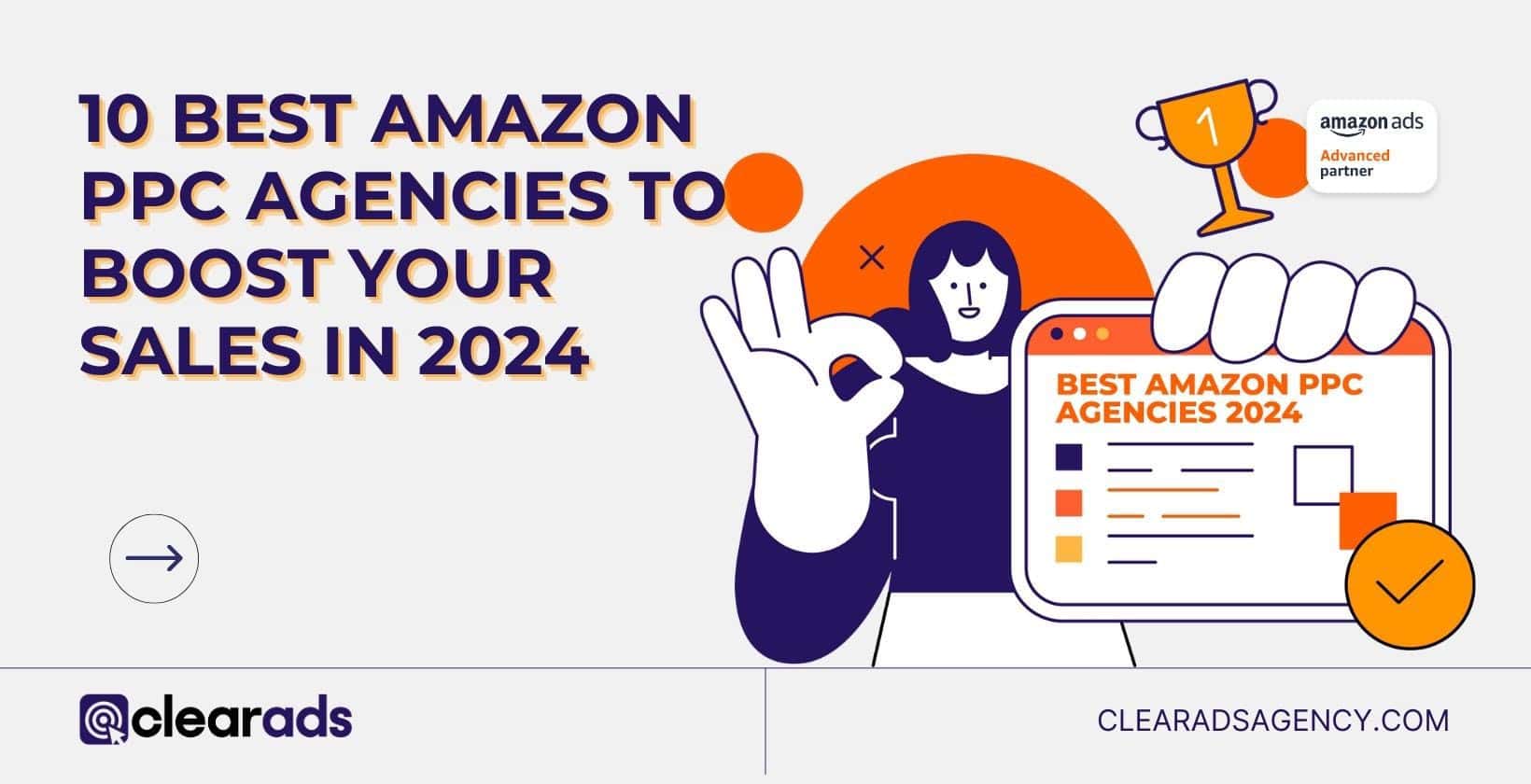An optimal Amazon PPC strategy demands more than just a budget and a handful of keywords. To truly thrive, sellers require a strategic approach that combines meticulous planning, precise targeting, and continuous optimization. A winning Amazon PPC strategy includes actionable insights to help businesses of all sizes maximize their advertising investment and unlock their full potential. From keyword research to performance analysis, this comprehensive guide equips sellers with the knowledge and tools they need to ascend the ranks and drive sustainable growth.
8 steps to building an Amazon PPC Strategy include keyword research, campaign structure, bid strategy, and more. A strategic approach sets the stage for a successful, sustainable advertising strategy that adapts to market dynamics, targets the right audience, and maximizes ROI. A successful Amazon PPC strategy hinges on 4 key elements: research, timing, planning, and ad types. To set clear goals for an Amazon ad campaign, determine your focus through research. Market research offers critical insights into customer behavior, competitor positioning, and industry trends. The ad type you choose will depend on your campaign goals, target audience, and budget. To ensure that your bids and budget are in sync with your strategic objectives, it’s crucial to begin by comprehending the worth of each conversion. Competitive analysis and market research are essential components of an effective Amazon PPC strategy. Sellers should avoid common mistakes like neglecting negative keyword management, setting inadequate budgets, and ignoring performance analytics. The best PPC strategy for sellers looking to build a brand on Amazon includes using Sponsored Brand Ads for visibility, targeting high-value and branded keywords, optimizing product listings with rich content, and regularly reviewing campaign performance to refine bidding strategies and ad placements.
An Amazon PPC (Pay-Per-Click) strategy is a structured plan that sellers employ to effectively advertise their products on the Amazon platform. Through PPC campaigns, sellers bid on keywords and incur a cost each time a shopper clicks on their ad. These ads are featured in different sections of the Amazon platform, such as search results and product detail pages.
Having a well-defined strategy is imperative for the following 5 reasons:
- Increased Sales
- Enhanced Visibility
- Competitive Edge
- Brand Recognition
- Successful Product
- Launches
How to Develop an Effective Amazon PPC Strategy?
8 steps to building an Amazon PPC Strategy:
Keyword Research:
- Broad Keywords: Begin with broader keywords to cast a wide net and gather initial data.
- Long-Tail Keywords: Target users with specific intents using long-tail keywords. These often have lower competition and cost, providing a more focused reach.
Campaign Structure:
- Automatic Campaigns
- Manual Campaigns
Bid Strategy:
- Cost-Per-Click (CPC)
- Dynamic Bids: Enable Amazon to adapt your bids in real-time, leveraging data on conversion likelihood to optimize ad placement.
Budget Management:
- Daily Budget: Set a daily spending limit to manage your advertising expenses effectively. This helps control costs and prevents overspending.
- ACoS (Advertising Cost of Sale): Strive for a balanced ACoS that aligns with your goals. Having a target ACoS in mind before you activate your campaign will ensure you stay on track.
- It is easy to get carried away in wanting a very low ACoS when that may not align with your strategy! For new product launches, sellers will want a higher cost on advertising to give the product an immediate push.
Ad Formats:
- Sponsored Products
- Sponsored Brands
- Sponsored Display
Product Listings Optimization:
- Compelling Titles and Bullet Points
- High-Quality Visuals
Performance Analysis and Optimization:
- Reporting Tools: Leverage Amazon’s comprehensive reporting tools to gain deep insights into your campaign performance. Analyze metrics such as CTR, conversion rate, and ROI.
- Continuous Optimization
Seasonal and Promotional Campaigns:
- Strategic Planning: Plan and execute campaigns around seasonal trends and promotional events. This allows you to tap into increased shopping activity during specific periods of the year.
Why is a Strategic Approach Essential for Amazon PPC?
A strategic approach sets the stage for a successful, sustainable advertising strategy that adapts to market dynamics, targets the right audience, and maximizes ROI.
- Efficient Resource Allocation – A thoughtfully designed strategy ensures that every dollar spent delivers maximum impact.
- Targeted Audience Reach – A well-constructed strategy identifies and targets the most relevant audience for your products. This results in higher conversion rates and a better return on investment (ROI).
- Gaining a Competitive Advantage – Outperform competitors and capture the attention of potential customers effectively.
- Optimized Ad Content – Creating compelling ad content ensures your message is consistent and leads to higher click-through rates (CTR) and conversion rates, ultimately boosting sales.
- Adaptability to Market Dynamics – Stay nimble and responsive to shifts in consumer behavior, industry trends, and competitor actions.
- Data-Driven Decision-Making – Make informed decisions for ongoing optimization.
- Maximized ROI – align every aspect of your advertising efforts toward achieving the highest possible revenue.
- Building Brand Visibility and Authority – Enhance brand recognition and trust among consumers for long-term brand authority.
- Sustainability
What Benefits Can Sellers Derive from a Well-Planned Amazon PPC Strategy?

1. Expansive Audience Reach with Optimal Returns
A well-crafted PPC strategy accelerates your reach, ensuring your products are showcased to a broader audience. This heightened exposure, when coupled with effective targeting, leads to a healthy Return on Investment (ROI), making every advertising dollar count.
2. Swift Top-of-Search Visibility
Swiftly ascending to the top of search results is a pivotal advantage of a strategic PPC approach. This prime visibility places your products directly in front of potential customers, increasing the likelihood of conversions and brand recognition.
3. Instant Surge in Traffic
Immediate traffic influx is a hallmark of a well-executed PPC strategy. By strategically placing your ads, you can attract relevant users to your listings, jumpstarting your sales and online presence.
4. Enhanced Control over Optimization
A thoughtfully planned PPC strategy provides you with more control over the optimization process. You can fine-tune keywords, adjust bids, and optimize ad content based on real-time data and performance metrics, ensuring your advertising efforts are always on point.
5. Valuable Data Collection
A strategic PPC campaign is not just about immediate results; it’s also a potent data-gathering tool. Through user interactions, click-through rates, and conversion metrics, you gain valuable insights into customer behavior. This data can be leveraged for ongoing campaign refinement and overall business strategies.
What are the Key Elements of a Successful Amazon PPC Strategy?
A successful Amazon PPC strategy hinges on 4 key elements: research, timing, planning, and ad types.
- Thorough market research provides essential insights into customer behavior and competitor positioning.
- Clear campaign goals, whether it’s brand awareness, sales, or product launches, give direction to your efforts.
- Choosing the right ad types such as Sponsored Product Ads for sales or Sponsored Brand Ads for brand visibility aligns with your specific objectives.
- Timing is crucial, knowing when to deploy each type of ad will ensure optimal results.
How Do You Set Clear Goals for Your Amazon PPC Campaigns?
- Assess Your Business Needs
What are you trying to achieve through the campaign?
- Define Targets – short vs. long-term goalposts
- Focus On Results
- Set Baseline and Stretch Goals
- Baseline goals provide a realistic and achievable target that a team or organization should aim to meet. They serve as a foundation for performance evaluation and ensure that essential objectives are met consistently.
- Stretch goals are ambitious targets that may initially seem beyond reach. They challenge teams to think creatively, innovate, and explore new approaches. They inspire higher levels of performance and encourage teams to push their limits.
- Analyze Performance Understand the factors that contributed to success to identify strengths and best practices. Or delve into the root causes of a failed campaign for targeted adjustments and improvements.
Are your goals realistic? If you are selling a product in a competitive marketplace you should reevaluate your objectives. Set realistic goals to keep on track.
Identify what a successful campaign will look like for your business and audience. Decide on the time frame you will give yourself and it will keep you focused
Outline a specific target (3% increase in sales), a clear timeframe (by January 2025), and a measurable outcome (1% reduction in CPA). This type of goal-setting provides a concrete and actionable objective. It allows for precise evaluation of performance and facilitates effective decision-making to achieve the desired results.
Why is Market Research Crucial for Amazon PPC Strategy Development?
Market research offers critical insights into customer behavior, competitor positioning, and industry trends. This data allows you to tailor your strategy to meet customer demands effectively.
- Understand Consumer Behaviour
- Identify Relevant key terms
- Competitor insights
- Spot trends and market changes
- Optimize budgets
How Do You Choose the Right Types of Ads for Your Strategy?
The ad type you choose will depend on your campaign goals, target audience, and budget:
- Sponsored Product Ads: These are optimal for showcasing specific products. They benefit from prominent placement within search results, making them highly effective for product-centric campaigns. These ads draw attention to individual items and drive direct conversions.
- Sponsored Brand Ads: Sponsored Brand Ads showcase your brand logo, a custom headline, and multiple products. They are instrumental in building brand authority and trust among potential customers.
- Sponsored Display Ads: This ad format has the transformative ability to target a wider audience base. It extends beyond keyword targeting, allowing for effective re-engagement. By reaching users based on their browsing and shopping behavior, Sponsored Display Ads are instrumental in capturing potential customers who may not have been directly searching for your products.
To create a truly impactful strategy, consider leveraging a combination of these ad types. This comprehensive approach ensures that you cover all areas of the marketplace and maximize your reach within Amazon’s platform.
By diversifying your ad formats, you create multiple touchpoints for potential customers, enhancing your chances of engagement and conversion. This strategic combination will tap into various segments of your target audience, amplifying the effectiveness of your overall advertising efforts.
Which Campaigns Benefit Most from Sponsored Product Ads?
Sponsored product ads are particularly potent for both targeted product promotion and new sellers. Product ads present a valuable opportunity to market seasonal items in advance. These ad placements guarantee visibility among potential customers, making them an excellent tool for driving sales and spotlighting individual products during any period.
When would you use Sponsored Product Ads:
- Product Visibility: Sponsored product ads provide prime placements within the search results for individual products. Use this ad type when you need to launch a singular product or boost sales quickly.
Their unique placement amongst organic products influences conversion rates and increases impressions. - Clear Call-to-Action: Sponsored product ads are brilliant for products with a clear value proposition and a compelling call-to-action.
- The buy now feature offers shoppers with a quick purchase option, and a clear CTA will influence impulse buyers.
- Seasonal Promotions: During peak seasons or promotional events, these ads can be highly effective in capitalizing on increased shopping activity.
- Competition with Similar Products: If you’re in a competitive niche with similar products, Sponsored Product Ads can help your listings stand out and attract potential buyers.
- Specific Targeting Needs: When you have specific keywords or product attributes you want to target, Sponsored Product Ads allow you to do so effectively.
Sponsored product ads are the foundation of an ad campaign and it is recommended that sellers use these alone or in conjunction with the other ad types.
When Should Sellers Opt for Sponsored Brand Ads?

Sellers with a diverse product range aiming to elevate brand visibility should opt for Sponsored Brand Ads. Brand ads offer a platform to convey a brand’s story, making them effective for sellers wanting to boost brand visibility. They effectively showcase more of your brand than a singular product ad so work well in conjunction with other ad types.
Brand ads require sellers to sign up for the brand registry program, which comes at no extra cost to the seller. However, signing up for this gives them access to unique tools and analytics like a storefront, A+ content, brand analytics, and much more. Because of this, Sellers should opt for brand ads when they are ready to develop their business.
Here’s why Sponsored Brand Ads are an invaluable tool:
- Brand Visibility: These ads establish brand recognition and create a powerful visual presence. They showcase your brand logo, craft a customized headline, and display multiple products together for a compelling brand representation.
- Spotlight on Product Collections: For sellers looking to spotlight a variety of products or promote specific product lines. Brand ads can showcase multiple products at once to promote a collection like frequently brought together or seasonal products.
- Competitive Edge: Sponsored Brand Ads secure a prominent position at the top of search results, providing a golden opportunity to capture attention for pivotal keywords.
- Fostering Brand Loyalty: With regular exposure to a compelling narrative, brand ads can foster a connection with customers. This will reengage them in other products you have or repurchase.
- Seasonal Campaign Advantage: These ads are tailor-made for seasonal promotions and campaigns. They present a unified brand image during holiday seasons or special events, ensuring your brand stays top-of-mind. Using these ads in the lead-up to a special day like Prime Day will encourage consumers to purchase from you when the deals come!
How are Sponsored Display Ads Transforming PPC Strategies?
Use in conjunction with other ad types Sponsored Display Ads extend your reach to potential customers, particularly those who have interacted with your products or brand before. This capability for re-engagement enhances retargeting efforts, broadening the scope and impact of your advertising strategy.
Sponsored Display ads are unique in their capacity to appear on and off Amazon. This engages customers wherever they are for a cohesive shopping experience. Display ads are great for advertisers who are enforcing an omnichannel marketing strategy as they promote a consistent brand experience. These ads use advanced targeting options to reengage and attract a much broader audience for maximum impact.
They offer various ad types including audio and video ads to engage customers however and wherever they shop. These prove highly effective at increasing the reach of products and expanding the audiences, especially interactive ads.
6 ways Sponsored display ads transform strategy:
- Expanded Reach
- Precise Retargeting Capabilities
- Diverse Ad Formats: display, video, and custom ads.
- Cost-Effective Campaigns: Pay-per-click model.
- Transparent Reporting
- Cross-Device Reach: Reach users across Amazon platforms and devices, including desktop, mobile, and Fire tablets.
How Do You Adjust and Optimize Your Amazon PPC Strategy Over Time?
Regular adjustments involve monitoring performance metrics like CTR, conversion rates, and ACoS. Adjustments may include refining keywords, refining ad copy, and modifying bid strategies. Continuous analysis and refinement ensure the strategy stays aligned with the set goals and market trends.
Starting a new campaign you will have very little data on your products. Less data gives advertisers less control over their campaigns and targeting options. It is best practice to engage in market and keyword while developing your strategy to understand the target audience for the product and how competitive the marketplace is. Understanding the audience will provide a significant head start when setting up the campaigns.
Over time you will gather more data on the product, audiences, and shopping patterns. This data will give advertisers the information needed to make any necessary adjustments to creatives, bids, and placements. The more information available will allow for a direct campaign that achieves the set goals.
Remember to have a clear understanding of what the goal of any campaign is before you start. This is what influences all optimization throughout the running of the campaign. It will prevent any unsuccess through a mix-match strategy.
What are the Best Practices for Continuous PPC Strategy Evaluation?
How Do You Ensure Your Bids and Budget Align with Your Strategic Goals?
To ensure that your bids and budget are in sync with your strategic objectives, begin by comprehending the worth of each conversion.
Allocate budget resources per the anticipated return on ad spend (ROAS) for specific products or campaigns. Tailor bids to give precedence to high-value keywords and products. Consistently keep an eye on and fine-tune your bids and budgets to optimize ROI and maintain alignment with your overarching goals.
Why is Budget Allocation Critical in Amazon's PPC Strategy Planning?
Why is A/B Testing an Integral Part of a Dynamic Amazon PPC Strategy?
How Does Keyword Research & Selection Influence Your PPC Strategy?
Targeting the right keywords is the foundation of an Amazon PPC strategy as it determines when your ads are displayed. Effective keyword research and selection ensures your ads are shown to users actively searching for products like yours. Thorough research helps you identify the most relevant and high-performing keywords, optimizing your ad’s visibility and relevance.
What Techniques are Effective for Keyword Research in Amazon PPC?
How Can Sellers Strategically Implement Negative Keywords?
How Do Competitive Analysis and Market Research Fit into Amazon PPC Strategy?

What Role Does Analytics Play in Refining Amazon PPC Strategy?
Are There Advanced Tactics to Boost Your Amazon PPC Strategy?
How Can Dayparting Enhance Your PPC Strategy on Amazon?
Why Should Sellers Consider Geotargeting in Their Amazon PPC Strategy?
How Should Sellers Adjust Their Amazon PPC Strategy for International Markets?
How Do External Factors, like Seasonality, Impact Amazon PPC Strategies?
External factors such as seasonality play a significant role in Amazon’s PPC strategies. During peak seasons, consumer behavior and competition levels fluctuate. Adjust your keyword strategy to align with seasonal trends, increase ad spend to capitalize on heightened demand, and optimize ad content to resonate with holiday shoppers.
What are the Strategies for Amazon PPC During Peak Sales Seasons?
During peak sales seasons, focus on aggressive bidding strategies to maintain visibility in competitive markets. Launch special promotions or offers to entice holiday shoppers. Expand your keyword list to capture seasonal search trends. Additionally, ensure your product listings are optimized for high-conversion potential.
How Do Seasonal Trends Affect Amazon's PPC Strategy and Its Execution?
Seasonal trends significantly impact Amazon’s PPC strategy execution. Recognizing and capitalizing on these trends allows sellers to target consumers at the right time with relevant products. This may involve creating specific campaigns centered around seasonal keywords and adjusting budgets to accommodate increased demand.
What Mistakes Should Sellers Avoid in Their Amazon PPC Strategy?
Sellers should avoid common mistakes like neglecting negative keyword management, setting inadequate budgets, and ignoring performance analytics. Additionally, overlooking ad relevancy, disregarding A/B testing, and failing to optimize product listings can hinder the effectiveness of an Amazon PPC strategy.
How Can You Prevent overspending on Your Amazon PPC Campaigns?
To prevent overspending in Amazon PPC campaigns, set daily and monthly budget caps. Regularly monitor campaign performance and adjust bids to ensure they align with your budget limits. Utilize negative keywords effectively to exclude irrelevant traffic and focus your ad spend on high-converting keywords and audiences.
What is the best PPC Strategy for Sellers looking to build a brand?
The best PPC strategy for sellers looking to build a brand on Amazon includes using Sponsored Brand Ads for visibility, targeting high-value and branded keywords, optimizing product listings with rich content, and regularly reviewing campaign performance to refine bidding strategies and ad placements. It is best practice in the strategy to encourage customer reviews and maintain consistent branding across all marketing materials.
Incorporate this into a brand-building strategy:
- Sponsored Brand Ads: These ads help customers familiarize themselves with your brand’s unique value proposition and full product range.
- Keyword Selection: Carefully research and select keywords that are closely aligned with your brand and products. Include both generic and long-tail keywords that potential customers are likely to use when searching for products in your category. High-value keywords that are relevant to your product can drive more targeted traffic, leading to better conversion rates and reinforcing brand positioning.
- Listing Optimization with A+ Content: By creating enhanced brand content with detailed descriptions, high-quality images, and comparison charts, you can improve the customer experience. This content not only assists in converting potential leads but also helps in achieving higher organic rankings, as it can lead to increased dwell time and better sales performance, both of which are positive signals to Amazon’s ranking algorithm.
- Performance Review and Adjustment: Use Amazon’s analytics tools to regularly assess the performance of your PPC campaigns. Look at metrics such as click-through rate (CTR), conversion rate, and return on ad spend (RoAS) to determine what’s working and what isn’t. Adjust your campaigns accordingly, whether it’s changing your keyword mix, altering bid amounts, or experimenting with different ad formats.
- Encourage Customer Reviews: Positive reviews are social proof that can elevate your brand’s credibility and organic ranking. Implement a follow-up strategy for customer feedback to encourage satisfied buyers to share their experiences. Amazon’s “Request a Review” feature can streamline this process.
- Consistent Branding Across Campaigns: Maintain a uniform brand message and aesthetic across all PPC campaigns to reinforce brand recognition. Your brand’s visual and messaging consistency is key to building trust and recognition with customers.
- Ad Spend Diversification: While focusing on PPC for immediate sales, also consider investing in other advertising channels offered by Amazon, such as Sponsored Display ads and Amazon DSP, to extend your reach. This can introduce your brand to customers not actively searching for your products but who may be interested based on their browsing and buying habits.
- Leverage Seasonality: Align your PPC campaigns with shopping events and seasons to capitalize on increased traffic and search volume. Create special promotions and themed advertising campaigns for events like Prime Day, Black Friday, and holiday seasons to maximize visibility and sales during peak shopping times.
By incorporating these strategies, sellers can create a robust PPC campaign framework that not only drives sales but also builds and sustains brand recognition on Amazon’s competitive platform.
How can Amazon ads be used to boost brand awareness?
Amazon ads can enhance brand awareness by leveraging Sponsored Brand and Display Ads to showcase your logo and products, creating an Amazon Store for an immersive brand experience, using video ads for engaging storytelling, and optimizing keyword and product targeting to reach relevant customers. Regularly updating product pages with A+ Content also helps in reinforcing brand messaging.
A strategic approach to PPC campaigns stands as the cornerstone of success for sellers. It’s a multifaceted endeavor that requires a keen understanding of consumer behavior, keyword relevance, and the intricate workings of Amazon’s search algorithms. By leveraging the power of Sponsored Brand and Display Ads, creating captivating brand stores, and delivering compelling product narratives through A+ content, sellers can significantly amplify their brand presence. As the marketplace continues to evolve, so must the strategies deployed by sellers, always aiming to stay ahead of the curve and maintain a pivotal presence amidst fierce competition. The journey to brand prominence on Amazon is continuous and demanding, but with the right PPC tactics, it’s a path well paved for enduring success.

